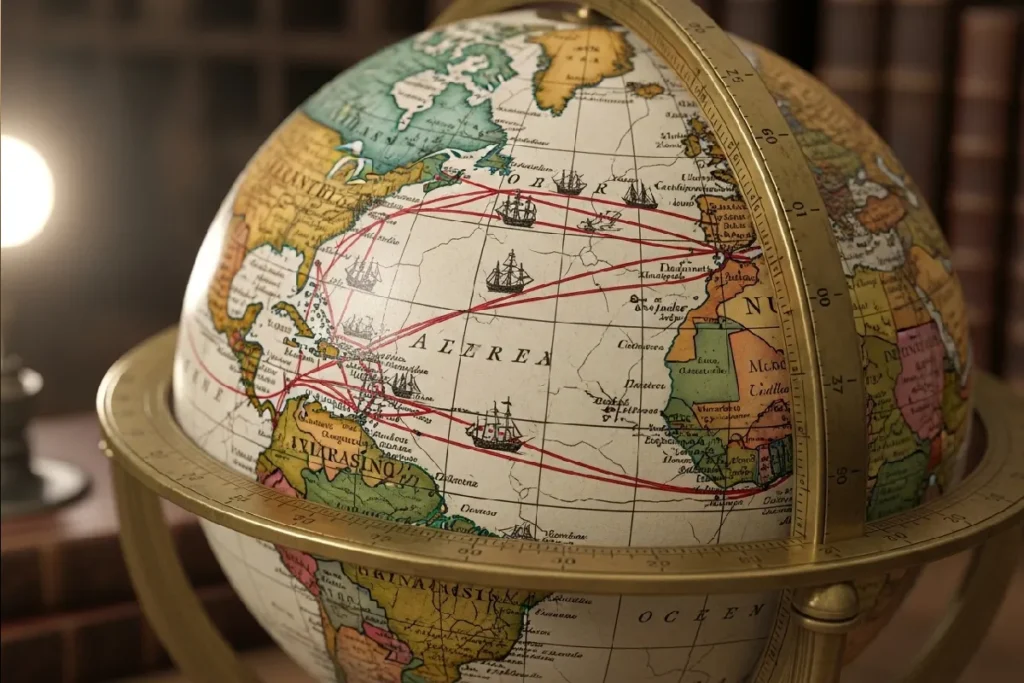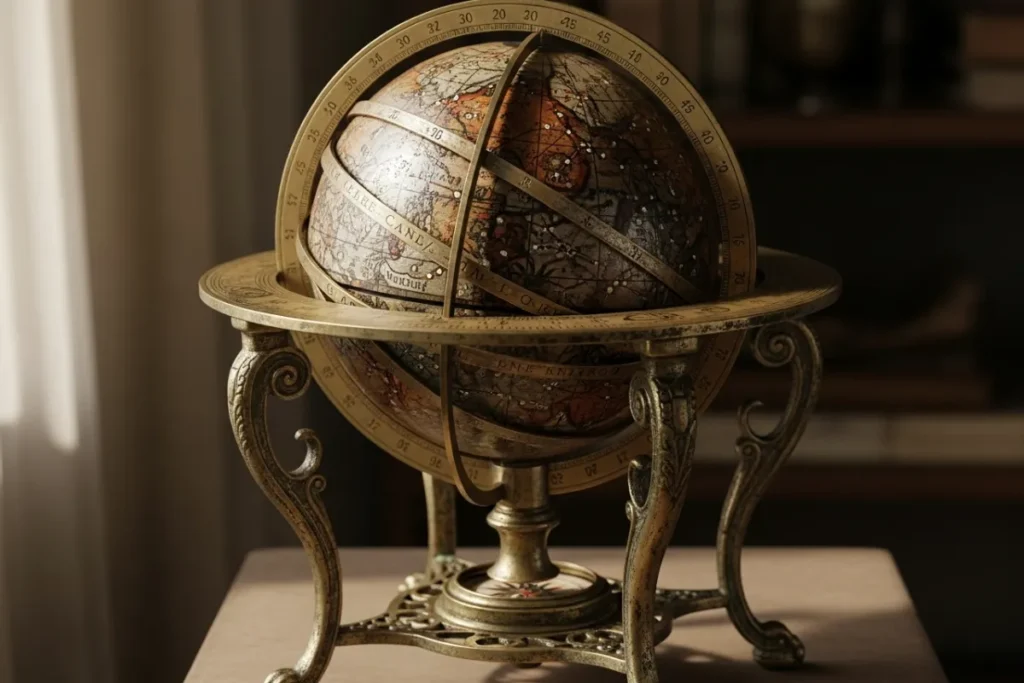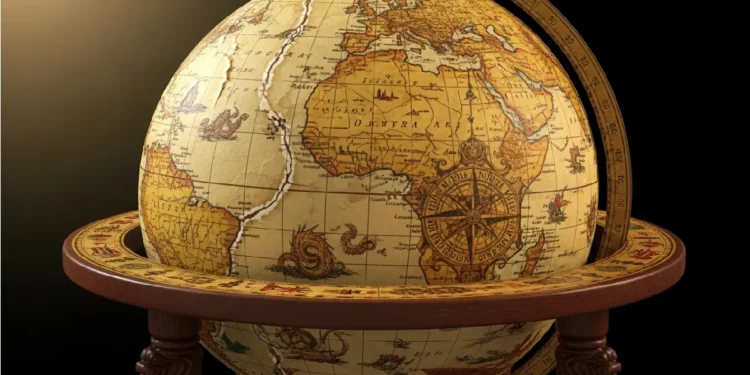Explore the intricate relationship between the History of Globe, cartography, and power in history, uncovering how colonial map design and globes shaped the narratives of exploration, conquest, and dominance. This post examines the evolution of cartography as a tool for political control and how the symbolism of globes reflects shifting ideologies over time. Delve into the profound implications of historical geography tools in understanding contemporary global relations and the enduring legacy of colonialism in modern mapping practices.
Table of Contents
Introduction to the History of Globe
The globe serves as a fundamental tool within the broader discipline of cartography, representing not merely geographical realms but also the intricate web of power dynamics that have shaped civilizations throughout history. From its earliest origins, the globe was more than a mere physical object; it embodied the political ambitions and ideological constructs of its time. The historical significance of globes is interwoven with themes of exploration, conquest, and colonialism, reflecting the narratives crafted by those in power.
During the age of exploration, political globes became essential instruments for colonial powers seeking to expand their territories. The design of colonial maps often aimed to depict the world in a manner that justified the domination and subjugation of foreign lands. These maps were meticulously crafted to convey a sense of superiority and control over the depicted territories. Ultimately, colonial map design not only facilitated navigation but also served as propaganda tools, highlighting the geopolitical interests of the nations behind them.
The symbolism inherent in globes goes beyond their physical representation; it encapsulates the conceptual frameworks through which societies understand their place in the world. Historical geography tools, such as globes, have been pivotal in shaping not only geographical knowledge but also the ideologies that have resulted in global hierarchies. These artifacts tell stories of conquest and colonization, as well as resistance and resilience.
In this exploration of the globe’s history, one can discern the profound impact of cartography and its power connection. The narratives surrounding globes paint a vivid picture of how geography has been manipulated to serve the interests of the powerful. As we delve deeper into this subject, we will uncover the multifaceted relationships between globes, cartography, and the unfolding of historical events that have shaped our modern world.
The Evolution of Cartography and Power
The relationship between cartography and power has evolved dramatically over the centuries, serving as a critical tool for empires and nations to assert their dominance. Early globes and maps were not merely representations of geographical territories; they were also cultural artifacts that encapsulated the ideologies and aspirations of the societies that created them. During the Age of Exploration, for instance, European powers utilized colonial map design to legitimize their territorial claims and facilitate the exploitation of new lands and resources. Such practices highlight how cartography was intrinsically linked to imperial ambitions.
In the context of the 19th century, political globes became symbols of national pride and power. They reflected changes in territorial control and were often commissioned as instruments of propaganda. The depiction of certain areas as “civilized” while others remained “untamed” reinforced colonial narratives and justified imperial expansion. This manipulation of cartographic representations can be seen as a means to exercise control over not just land, but also peoples and cultures, cementing the link between cartography and geopolitical power.
With the advent of modern technology and increased precision in mapping techniques, historical geography tools have further broadened our understanding of how maps have shaped perceptions of power throughout history. Today, the symbolism inherent in globes continues to evolve. While representing a globe can evoke notions of global unity and interconnectedness, it can also mask underlying power dynamics that persist in contemporary geopolitics. Thus, as we explore the evolution of cartography, it becomes evident that maps are not neutral documents; they are laden with significance, often wielded to influence and control perceptions of power. The historical trajectory of cartography and power serves as a testament to the profound implications that maps and the representations they convey can have on our understanding of the world.

Colonial Map Design and Its Consequences
Colonial map design played a central role in the way Western powers conceptualized and exerted their influence over territories and cultures during the era of imperial expansion. These maps and political globes were not merely practical tools for navigation; rather, they symbolized and legitimized the dominance of colonial rule over newly acquired lands. The design principles embedded in these maps often reflected a Eurocentric view of the world, where European civilizations were depicted as the apex of development, while other cultures were portrayed as primitive or in need of ‘civilization’.
Maps produced during the colonial period often utilized cartography to illustrate vast empires, significantly enhancing the perception of power. The selective inclusion and exclusion of geographical features and social hierarchies allowed colonial powers to impose their ideological frameworks on the territories they sought to control. For instance, the choice to label regions with European names while disregarding indigenous titles served to erase local identities and cultures. This form of cartography not only justified the expansionist ambitions of colonial rulers but also facilitated the exploitation of resources and peoples.
Furthermore, political globes of the time often showcased a distorted view of the world in favor of the colonizers, reinforcing the notion of Western superiority. Globe symbolism during this period was tightly intertwined with the ideologies of the age, as it visually represented the reaches of empire and the strategic importance of certain locations. This manipulation of historical geography tools served not just as a method of navigation but as a means of indoctrination, shaping public perceptions of global hierarchies.
The consequences of these practices are profound and far-reaching, influencing contemporary understandings of space, power, and identity. The legacy of colonial map design continues to evoke discussions about representation and cultural hegemony, warranting critical examination of how historical narratives have been constructed through cartography.
Political Globes: A Tool for Narrative Control
Throughout history, political globes have emerged as significant instruments for narrative control, allowing powerful nations to shape and manipulate public perception as well as international relations. The intricate relationship between cartography and power cannot be overstated; maps and globes have been used not only to delineate territory but also to reflect the ideologies and ambitions of their creators. As tools within the larger framework of historical geographic practices, political globes often embody a specific worldview that aligns with a country’s geopolitical agenda.
The symbolism inherent in globes has made them particularly effective as a medium for propaganda. National governments have historically commissioned globe design to reflect their sociopolitical narratives. For instance, the way borders are drawn, the prominence given to certain regions, and the absence of others often serve to emphasize a nation’s power and authority. A globe may portray a linear historical narrative designed to legitimize territorial claims, erasing the complex realities of indigenous populations and local histories.
Moreover, these political globes serve dual functions as both educational resources and instruments of persuasion. They are showcased in classrooms and government buildings, subtly educating individuals about a nation’s strategic importance while concurrently reinforcing existing power dynamics. Colonial map design, for example, often played a role in justifying expansionist policies by depicting conquered lands as vacant or underdeveloped. This manipulation can influence how citizens view their own country’s role in global affairs and can exacerbate existing prejudices.
In essence, the interplay between globe symbolism and political agendas highlights the integral role that cartography, including political globes, has played throughout history as a means of controlling narratives and shaping perceptions. Understanding these dynamics is essential for assessing the impact of historical geography tools on modern geopolitical contexts.

Globe Symbolism: More Than Just Geography
The significance of globes transcends mere geographic representation; they have served as powerful symbols intertwined with ideals of power, authority, and knowledge throughout history. At their core, globes are representations of the world, yet they often reflect the political and ideological landscapes of their times. The relationship between cartography and power is evident when examining historical maps and models that prioritize certain regions over others, thereby imposing a specific worldview.
Colonial map design, for instance, utilized globes not only as tools for navigation but also as instruments of domination. During the age of colonialism, maps were crafted to underline the supremacy of European powers, frequently omitting or misrepresenting indigenous lands and cultures. This intentional distortion of reality served to validate colonization, acting as a visual proclamation of ownership and control. As such, political globes became embodiments of the ideology that supported Western hegemony, showcasing how cartography can manipulate perceptions of the world.
Moreover, globe symbolism extends to the realm of knowledge and education. For centuries, they have been utilized as tools for enlightenment, embodying the quest for understanding the world. Educational institutions adopted globes to convey geographic knowledge, while simultaneously promoting an agenda of Western progress and modernity. The symbolic nature of these globes often masks the underlying narratives of conquest and subjugation associated with their design.
In different cultural contexts, globes can represent notions of universality and enlightenment or, conversely, serve as reminders of domination. Thus, the subtle nuances of globe symbolism reveal how historical geography tools can shape identities, ideologies, and perceptions of power. Ultimately, the dual representation of globes invites us to reconsider their role not just as geographic tools but as artifacts laden with the weight of history and the complexities of human interaction.
The Role of Historical Geography in Understanding Power Structures
Historical geography serves as a critical lens through which the nexus of cartography and power can be examined. This discipline critically investigates how geographical knowledge and representations, particularly in the form of maps and globes, have shaped, and often dictated, social and political hierarchies throughout history. The design of colonial maps, for instance, went beyond mere topographical representation; they were instruments of imperialist ideologies, articulating and reinforcing power structures in various regions.
Colonial map design was often imbued with intentions that extended past geographical delineation, serving as a means to assert control over vast territories. Maps created during the colonial era not only depicted land features but also marked ownership and justified governance in foreign lands. The power dynamics reflected in these cartographic representations underscore the important role historical geography plays in understanding global power relations. Political globes, another manifestation of cartography, similarly convey ideologies, often representing nations and continents in ways that reflect the political ambitions of their creators.
The symbolism associated with globes extends into the realms of education and ideology, reinforcing specific narratives about territorial dominance and cultural hegemony. Such historical geography tools generate a deeper comprehension of how space and power intersect, revealing how the manipulation of geography in cartography fosters a hierarchical view of societies. Thus, an exploration of the globe’s symbolic significance further illuminates the ties between geographical representation and political authority, emphasizing that the knowledge we derive from maps is not neutral but rather laden with historical context and power implications. Through this lens, understanding the past allows for a more nuanced perspective on contemporary political structures influenced by centuries of cartographic practices.

Modern Interpretations of the Globe in a Globalized World
The globe, as a historical geography tool, has evolved significantly due to the influences of globalization. Once a representation primarily utilized for colonial map design, the modern globe now transcends geographic boundaries, emerging as a symbol not only of the earth’s physical features but also of interconnectedness among nations and cultures. In today’s society, where political globes are often employed in educational settings, they serve to reflect not just geographical data but also the political narratives that govern global relations.
Globalization has fostered a shared narrative that challenges traditional notions of nationhood and territoriality, revealing how cartography and power have influenced our perceptions of the world. Post-colonial critiques highlight how historical maps often served as instruments of domination, whereas contemporary interpretations advocate for inclusivity and represent diverse perspectives. This shift suggests a growing awareness of indigenous and marginalized voices that have often been omitted from traditional geopolitical discourses.
Furthermore, modern political globes are increasingly utilized in various media to raise awareness about global issues such as climate change, migration, and socio-economic disparities. This reflects a broader cultural shift towards recognizing our collective responsibilities as global citizens. As the world becomes more interconnected, the symbolism of the globe takes on new meanings—transforming from a tool representing dominance into one that underscores cooperation and solidarity across borders.
In contemporary discussions, the role of cartography as an art form grows deeper, integrating technology and data visualization to create maps that challenge conventional representations. By employing modern geographic tools, we begin to understand the complexities of our globalized world, revealing layers of meaning often hidden in traditional maps. The interplay of globe symbolism in our schools, political discourse, and cultural consciousness ultimately shapes our perception of the world and informs our interactions within it.
Critical Reflections on Cartography and Dominance
The intricate relationship between cartography and power is a subject that warrants thoughtful examination, particularly in the context of colonial map design and its enduring impact on historical geography tools. The act of mapping has historically been more than just a means of representation; it has served as a mechanism for asserting dominance, particularly during the era of European colonialism. The maps produced during this time often reflected a biased worldview, presenting colonized regions in ways that served the interests of colonial powers while disregarding the cultural and historical narratives of indigenous populations. This skewed representation raises critical questions about how contemporary practices in cartography are shaped by these historical legacies.
In today’s world, cartographers possess the responsibility of creating maps that are not only accurate but also inclusive and culturally sensitive. As we engage with political globes and other mapping practices, it becomes essential to consider the implications of what is represented and what is omitted. The symbolism of globes as instruments of power continues to resonate, reminding us that the way we visualize the world influences our understanding of it. This calls for a reevaluation of how we approach map-making, challenging practitioners to adopt a more reflective stance that recognizes the potential for perpetuating stereotypes and inequalities.
Moreover, it is crucial to question the methodologies employed in contemporary cartography and assess the extent to which they are informed by historical perspectives. Are new technologies paving the way for more equitable representation, or are they inadvertently perpetuating existing biases? By fostering a critical reflection on these practices, we can move toward creating maps that not only represent geographies but also honor the complexities of human experiences across various cultures. Addressing these questions allows for a deeper understanding of how the legacy of cartography and power continues to shape our views of the world today.
| Key Theme | Detail | Contemporary Implication |
|---|---|---|
| Cartography as Power Mechanism | Mapping has historically been used not just to depict geography but to assert political and military dominance, especially by European colonial powers. | Modern mapmakers must recognize how representation can reinforce power dynamics and strive for balanced perspectives. |
| Colonial Map Bias | Colonial-era maps often presented indigenous lands and peoples through a Eurocentric lens, marginalizing local narratives and cultural contexts. | There is a need to uncover and correct these biases when using historical geographic data or designing new maps. |
| Responsibility of Today’s Cartographers | Today’s practitioners bear a duty to create maps that are accurate, inclusive, and culturally sensitive, avoiding past misrepresentations. | Incorporate community input, multiple data sources, and transparent symbology to honor diverse histories and identities. |
| Symbolism of Political Globes | Globes continue to symbolize authority and worldview; what appears at the center or the periphery reflects underlying values and power relations. | Mapping has historically used not just to depict geography but to assert political and military dominance, especially by European colonial powers. |
| Methodological Reflection | Contemporary cartography must be interrogated for its methods—selection of data, projections, and visual conventions—all potentially shaped by legacy biases. | Encourage peer review, comparative studies, and ethical guidelines to ensure mapping practices evolve responsibly. |
| Technological Impacts | New mapping technologies (e.g., GIS, satellite imaging, AI-driven mapping) offer opportunities for more equitable representation but risk replicating old biases. | Leverage technology to amplify underrepresented voices, while auditing algorithms and data inputs for hidden biases. |
Conclusion: Reclaiming the History of the Globe
The exploration of globes and maps reveals a complex narrative intertwined with issues of power, colonialism, and representation. As noted by Tristram Hunt in The Guardian: ‘maps are about the expression and fulfillment of power’. It is imperative to recognize how cartography acted not merely as a tool for navigation but as an instrument of dominance throughout history. The development of colonial map design reflects the desires of imperial powers to impose their will on vast territories, often at the expense of indigenous cultures and perspectives. The symbolism embedded within political globes serves as a stark reminder of these historical dominations. When examining these historical geography tools, one begins to understand their role in shaping perceptions of the world and the implications for contemporary society.
The intricate relationship between cartography and power necessitates a reevaluation of how we engage with maps today. In modern contexts, the way we conceptualize space, governance, and cultural identity often draws upon these historical frameworks, perpetuating longstanding inequalities. By approaching maps and globes with a critical eye, we can unpack the layers of meaning they hold, revealing the socio-political narratives they perpetuate or obscure. This awareness empowers individuals to reclaim their representations while fostering a dialogue about heterogeneity and inclusivity in geographical discourse.
Ultimately, establishing a nuanced understanding of globes and cartographic history is crucial. It serves not only as an academic endeavor but as a vital component in addressing current global challenges. Engaging with the narratives embedded in these objects can aid in creating more equitable visions of representation and mapping in today’s world. Through this lens, we can begin to counteract the remnants of colonial ideologies that still impact our societies, reaffirming the potential of maps as tools for justice rather than oppression.








